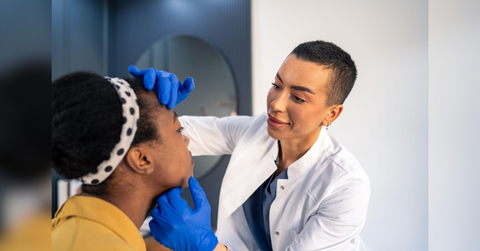 NEWS
NEWSWhy Exactly Are Skincare Lovers Turning to Salmon Sperm?

Aug. 6 2025, Published 1:50 a.m. ET
One minute you’re singing karaoke in a dive bar, the next, your favourite singer is on stage at The Carlyle telling the crowd she’s tried “that salmon sperm” - for her skin, of course. “Tastes strange,” she deadpans, “but my skin looks good.”
She wasn’t drinking it (thankfully). She was talking about a skincare trend that’s swimming back into the spotlight thanks to a new wave of injectables and serums featuring polynucleotides, aka small fragments of DNA, often derived from salmon.
If you’re thinking this sounds suspicious, you're not alone. But from well-known TV personalities to actors, singers, and celebrities are increasingly dipping their faces in fishy formulas. Some topically, others (under medical supervision) via injectable procedures that claim to regenerate, hydrate and heal the skin from within.
What’s the catch? In Australia, any treatment involving polynucleotides that is injected into the skin must be prescribed by a healthcare professional. That means you won’t find “salmon sperm facials” on your local salon menu. But it hasn’t stopped beauty lovers from getting curious or clinics from offering medical consultations for the polynucleotide-curious.
Why Salmon?
If you’re still calling it “the salmon sperm injection” without knowing what it actually does, you’re not alone. But it’s time to go deeper into the science behind Korea’s viral salmon sperm injection and why your dermatologist might genuinely rate it.
Yes, treatments like Rejuran use polynucleotides derived from salmon DNA. And no, this isn’t some quirky K-beauty gimmick designed for shock value. There’s a solid reason salmon keeps coming up in cosmetic science, and it starts with how similar its DNA is to people’s.
Salmon DNA is remarkably biocompatible with human tissue. That means your body doesn’t reject it - it actually works with it, allowing the polynucleotides to support natural regeneration and repair. Compared to other sources, salmon DNA’s structural similarity to human DNA makes it ideal for aesthetic use, especially when injected into compromised or aging skin.
Polynucleotides themselves have been shown to help stimulate wound healing, improve microcirculation, and increase skin elasticity. That’s why practitioners aren’t just using them for general rejuvenation - they’re also exploring their use in treating acne scarring, sun damage, and compromised skin barriers.
So yes, it might sound strange. But there’s a surprisingly elegant logic behind why this particular fish is leading the skin-repair charge.
What the Science Says
Speaking to the medical team at My Body Vibes, these treatments aren’t meant to “erase” imperfections overnight. “They work with your body’s own regenerative processes, which means results are gradual and vary between individuals,” they explain. “Most people notice changes in texture and resilience over time, but it’s not a quick fix.”
What’s unique about polynucleotides is how they’re used. Instead of targeting one specific area, treatments like Rejuran are typically applied across the whole face (or even neck), supporting subtle, natural-looking change. There are versions delicate enough for under-eyes - the kind of place filler fears to tread.
And because they play nice with other treatments, polynucleotides are becoming a staple in longer-term skin strategies. Think of it less like a miracle shot, more like a repair serum with a syringe.
How Do You Even Get DNA from a Salmon?
Despite the nickname, no sperm is being, well, harvested in the traditional sense. The DNA used in these treatments is typically extracted from the milt (a fluid containing sperm) collected during breeding cycles at fish farms.
Most companies using salmon DNA in medical-grade skincare source it from sustainably farmed salmon and refine it through complex purification processes that strip out cellular material, leaving behind the active fragments (polynucleotides). It’s highly regulated in countries like Korea and Australia.
So no, your serum isn’t fishy. And yes, the industry is increasingly transparent about its sourcing, especially as demand grows.
From Seoul to Social Media: How K-Beauty Pioneered This Trend
While it might be making waves in Beverly Hills now, polynucleotide therapy has long roots in Korea’s cosmeceutical tradition, where clinical skincare and beauty innovation intersect. Rejuran, one of the most well-known brands, first launched in South Korea nearly a decade ago, marketed under the category of “skin healing” rather than anti-aging.
Unlike the Western obsession with instant fixes, the Korean skincare philosophy favours gradual, compounding results, which is exactly how polynucleotides work. Think: less erasing wrinkles, more building stronger, more resilient skin over time.
As with BB creams and snail mucin before it, this could be another K-beauty traditional sculpting treatment that the Western world has finally caught up with.
Want OK! each day? Sign up here!
The Brain-Skin Connection
Interestingly, polynucleotides are also being studied in fields beyond cosmetics, including wound healing, nerve regeneration, and even ophthalmology. Some researchers believe their ability to modulate inflammation and support cellular repair could have broader implications for how damaged tissue is treated in the future.
For beauty lovers, that means these treatments aren’t just about glow; they may actually change the way skincare is thought of as part of whole-body repair.
Should You Try A Salmon Sperm Facial?
Honestly? Probably. Many people have done worse for less convincing science.
Compared to stirring collagen powder into a beige smoothie and pretending it’s working, injecting polynucleotides (which actually have peer-reviewed studies behind them) feels like a smarter gamble. It’s not magic, but it’s not pseudoscience either.
And despite the unfortunate nickname, the treatment itself isn’t nearly as bizarre as it sounds. Once you peel back the salmon sperm headline, what you’re left with is a regenerative skin booster backed by dermatologists, clinical reviews, and a growing global fanbase (celebrities optional).
So yes, if it fits your skin goals and budget, you should try a Rejuran treatment. Just don’t say “salmon sperm” out loud at the front desk.
What Do Celebrities and Salmon Sperm Have in Common?
They’re all part of the skincare conversation right now.
Heard being spoken about on reality TV shows, it’s clear this isn’t just some passing fad. When celebrities who influence beauty trends start sharing their experiences, people take notice.
After trying the treatment, one celebrity asked, shocked, “How do you get sperm out of a salmon?” This interest confirms that the treatment has officially gone mainstream. Stars often lead the way, trying bold, new skincare innovations - making it easier for everyone else to see what’s worth the hype. And maybe, just maybe, this one’s got some real staying power.
If you want to learn more about treatments like these, a chat with the medical team at My Body Vibes in Melbourne can provide more information and help assess whether this treatment aligns with your skin health needs.
This article is for informational purposes only and does not substitute for professional medical advice. If you are seeking medical advice, diagnosis or treatment, please consult a medical professional or healthcare provider.


